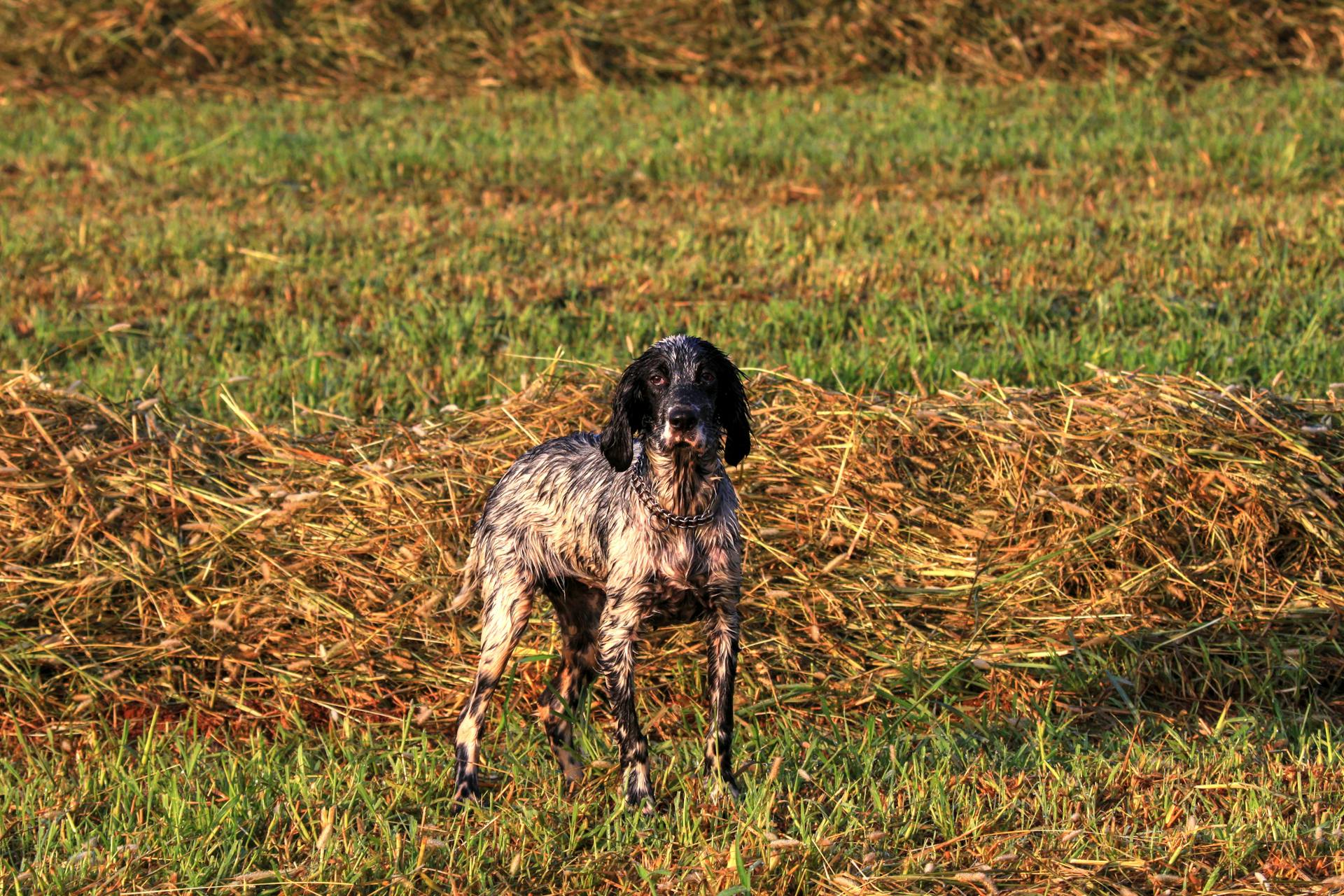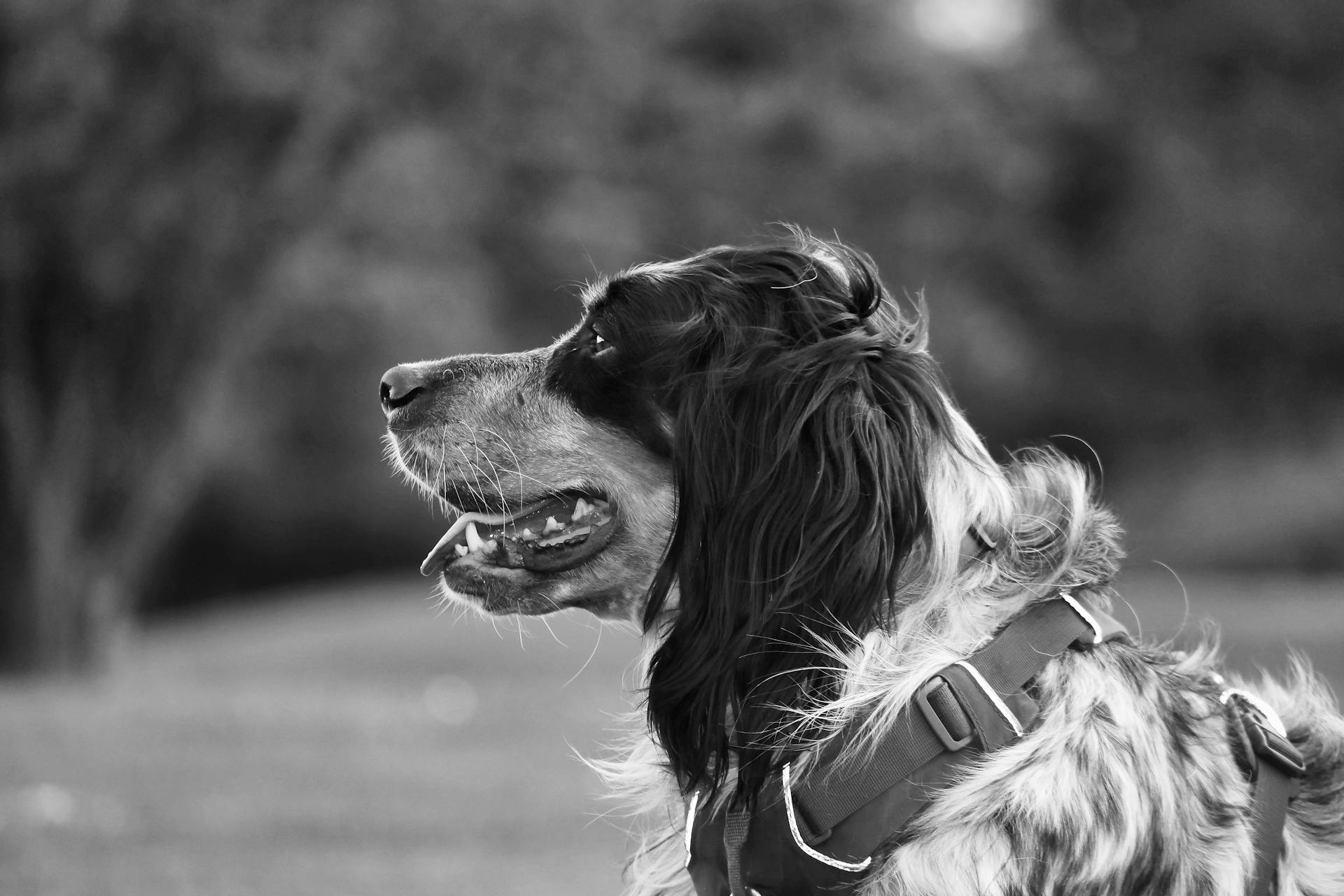
The English Setter is a stunning breed with a rich history. They originated in England in the 16th century as a hunting companion for the aristocracy.
Their beautiful coat requires regular grooming to prevent matting and tangling.
English Setters are known for their friendly and outgoing personalities. They make great family pets and are often described as "velcro dogs" because of their love of human attention.
Breed Characteristics
English setters are known for their distinctive hunting behavior, where they'll crouch low to the ground with their attention fixed on their quarry. This "setting" behavior was once essential for hunters to cast a net over the game without obstruction.
The breed group is classified as Sporting, and English setters typically stand between 23-27 inches tall and weigh 45 to 80 pounds. Their coat is flat, silky, and medium-length, with feathering on the ears, chest, belly, legs, and tail.
Here are the key characteristics of English setters at a glance:
- Height: 23-27 inches
- Weight: 45 to 80 pounds
- Coat length & texture: Flat, silky, medium-length coat with feathering
- Coat color: White base with intermingled blue, orange, or lemon "belton" markings
- Exercise needs: High
- Intelligence: High
- Barking: Only when necessary
- Life span: 10-12 years
- Temperament: Graceful, friendly, mellow, and playful
- Hypoallergenic: No
- Origin: England
Temperament

English setters are known for their gentle and calm temperament, often described as "Gentleman by Nature." They're a great choice for families with kids, who will love their playful and affectionate nature.
This breed is also highly intelligent, ranking 37th in Stanley Coren's The Intelligence of Dogs, and can learn to perform a wide range of tasks with proper training.
In fact, English setters are so intelligent that they can pick up basic training like sits, stays, and comes easily, making them a joy to work with.
However, their independent streak can sometimes make them prone to separation anxiety if left alone for too long, so be sure to provide plenty of attention and exercise.
English setters are also known for their territorial streak, which can make them protective around strangers, but they calm down quickly after being introduced.
As a result, they make great watchdogs, but also need plenty of socialization to ensure they get along with other dogs and people.
You might like: English Setter Training
With their strong instinct to please, positive reinforcement training methods using treats and praise work best when undertaking basic training.
Overall, English setters are a wonderful breed that thrive on attention and interaction, making them a great choice for active families or hunters who can provide them with the exercise and stimulation they need.
Appearance
English Setters are a medium-sized breed, with a range of sizes depending on their type. Males can weigh between 65-80 pounds and stand 25-27 inches tall, while females weigh between 45-55 pounds and stand 23-25 inches tall.
Their coat is one of their most distinctive features, with a white base and intermingled markings of blue, orange, or lemon. These markings are called "belton" and can come in various combinations, including blue, orange, lemon, and liver.
English Setters have a long, muscular neck and well-angled shoulders, making them sturdy and athletic dogs. Their tail is long and carried in line with their back, with feathering that reaches the hock.
Here's an interesting read: Lemon Belton English Setter
Their coat requires regular grooming, especially for the bench or show type, which has a long, flowing coat. The field or hunting type has a shorter coat that requires less grooming.
Here's a breakdown of the different types of English Setters and their characteristics:
It's worth noting that English Setters are born white, and their markings appear a few weeks later. These markings can vary in size and even form large patches, making each dog's coat unique.
How Often Do They Shed?
English setters shed moderately, but weekly brushing can help keep loose hair off your furniture and floors.
They require regular grooming to prevent matting and tangling of their coats.
English setters are a high-energy breed that needs regular exercise to stay happy and healthy.
Regular exercise also helps to reduce shedding, as it promotes a healthy coat and skin.
With proper care and attention, English setters can thrive in a variety of living situations, including homes with moderate to large yards.
Their intelligence and trainability make them a popular choice for active families and hunters.
Caring for Your English Setter
Caring for your English setter can be overwhelming, especially since they require more maintenance than most breeds.
Regular exercise is a must, along with tending to their grooming and dietary needs.
You'll need to schedule your dog's vaccinations and make a trip to the vet, not to mention puppy-proofing your home and preparing for teething.
English setters have a fancy coat that needs regular brushing, at least once a week, to prevent tangling and matting.
Use a soft bristle brush or long-toothed metal comb to keep their long hair looking its best.
Baths are necessary at least once a month, and you might want to trim that longer hair to keep it under control.
English setters don't shed as much as many other dogs, but regular brushing is still vital to remove leaves, pine needles, and small sticks from their coats.
Their soft, floppy ears need attention too, so clean them out every week to prevent any issues.
Trimming your English setter's nails and brushing their teeth regularly will also become part of your routine.
If you start grooming your English setter when they're still a puppy, it'll make the process faster and easier for everyone in the long run.
Intriguing read: Short Hair English Setter Puppies
Training Your English Setter
English setters are sensitive dogs that take punishment to heart, so it's best to use positive reinforcement training methods. They respond well to short, mentally stimulating training sessions packed with praise and rewards.
Their high prey drive can get them into trouble, so training them early for recall cues and keeping tempting food items out of reach is crucial. Try not to leave food on the kitchen counter, as they love to counter surf.
Setter puppies can be difficult to potty train at first, but starting training early and keeping sessions consistent can help. They'll learn to listen and respond to commands in no time.
Reward-based training methods are the way to go with English setters - they thrive on praise, play, and treats.
English Setter as a Family Dog
The English setter is a gentle, affectionate dog that's known for being especially good with kids. They make great family pets.
English setters are relatively easy to train, especially when started early. This makes them a great choice for families with children.
They're a social breed that thrives on human interaction, so they'll love spending time with your family.
Breeds Similar to
If you're considering an English setter but aren't sure, there are several other breeds worth looking into.
The Irish setter is a great alternative, with its energetic and elegant nature making it a beloved family dog. They're quick and have a flashy red coat.
Pointers are another medium-sized sporting breed with a long hunting history, rivaled only by the English setter's. They're ultra-energetic and need at least two hours of daily exercise.
The English springer spaniel is highly trainable and loves spending time with its family, but it hates being neglected. They're smart and sweet-faced, made for long hunting trips in the field.
If you're looking for breeds similar to the English setter, here's a list of some options:
- Irish setter: energetic and elegant
- Pointer: ultra-energetic and needs daily exercise
- English springer spaniel: highly trainable and loves family time
Featured Images: pexels.com

